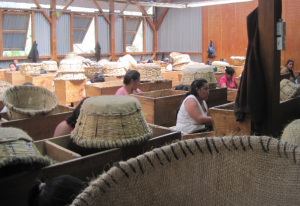by Patricia Hamill
Summer 2012 InGear

FIDESMA’s ability to offer microcredit is directly connected to its participation with P4P. If not for the bicycles and sewing machines they sell, FIDESMA would not be able to offer the loans so needed by local farmers in order to evolve from subsistence farming to business owners with progressive agricultural practices. Progressive? This isn’t about planting what you can on a squat impoverished patch of dust. While there was a limited supply of fresh and nutritious vegetables in town, the land itself is not to blame. The same rich soil that enables the coffee planters to thrive can of course support other types of agricultural interests. Poverty and lack of access to large plots of land are primarily what keeps local people from cultivating their own farms for personal use and larger distribution, so FIDESMA invested in a community garden with the hope that a greater supply of locally grown produce with higher nutritional value than what is currently found in the marketplace would initiate a movement towards physical and financial health in the region.
A group of 12 full-time farmers, each with 2 helpers, rents the land from FIDESMA under a 3-year contract. Strawberries, tomatoes, peppers, peas, and corn all grow in raised beds fed with drip irrigation which is gravity fed from the hillside above. Fertilizer flows through the drip irrigation system and hoop houses. Remay fabric is often used to keep pests off or to protect the plants from extreme weather exposure. These accomplishments are not solely the result of FIDESMA’s micro-lending practices. Many people in this region have generations of agricultural expertise to draw from. What they lacked was a source of affordable financing and privately owned land to apply their knowledge while also having access to updated technologies and tools.
The result of this collaboration is a plethora of nutritious vegetables in the local market, grown by independent farmers who also export to neighboring communities, thus generating a greater income circulation than small individual slope-side plots could provide.
